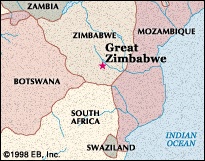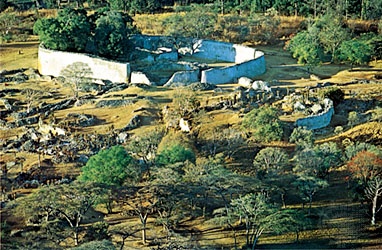Great Zimbabwe
ancient city, Zimbabwe

extensive stone ruin of an African Iron Age city. It lies in southeastern Zimbabwe, about 19 miles (30 km) southeast of Masvingo (formerly Fort Victoria). The central area of ruins extends about 200 acres (80 hectares), making Great Zimbabwe (World Heritage site) the largest of more than 150 major stone ruins scattered across the countries of Zimbabwe and Mozambique.
It is estimated that the central ruins and surrounding valley supported a Shona population of 10,000 to 20,000. With an economy based on cattle husbandry, crop cultivation, and the trade of gold on the coast of the Indian Ocean, Great Zimbabwe was the heart of a thriving trading empire from the 11th to the 15th centuries. The word zimbabwe, the country's namesake, is a Shona (Bantu) word meaning “stone houses.”
The site is generally divided into three main areas: the Hill Complex, the Great Enclosure, and the Valley Ruins. The first two are characterized by mortarless stone construction, but they also include ruined daga (earthen and mud-brick) structures that may once have rivaled the stone buildings in grandeur. The Valley Ruins, located between the Hill Complex and the Great Enclosure, include a large number of mounds that are remnants of daga buildings.
The Hill Complex, which was formerly called the Acropolis, is believed to have been the spiritual and religious centre of the city. It sits on a steep-sided hill that rises 262 feet (80 metres) above the ground, and its ruins extend some 328 feet (100 metres) by 148 feet (45 metres). It is the oldest part of the site; stratigraphic evidence shows that the first stones were laid there about the year 900. The builders incorporated natural granite boulders and rectangular blocks to form walls up to 20 feet (6 metres) thick and 36 feet (11 metres) high. Within the walls are the remains of daga houses.
 South of the Hill Complex lies the Great Enclosure, the largest single ancient structure in sub-Saharan Africa. Its outer wall is some 820 feet (250 metres) in circumference, with a maximum height of 36 feet (11 metres). An inner wall runs along part of the outer wall forming a narrow parallel passage, 180 feet (55 metres) long, which leads to the Conical Tower. The purpose of the tower, 33 feet (10 metres) high and 16 feet (5 metres) in diameter, is unknown, but it may have been a symbolic grain bin or a phallus symbol.
South of the Hill Complex lies the Great Enclosure, the largest single ancient structure in sub-Saharan Africa. Its outer wall is some 820 feet (250 metres) in circumference, with a maximum height of 36 feet (11 metres). An inner wall runs along part of the outer wall forming a narrow parallel passage, 180 feet (55 metres) long, which leads to the Conical Tower. The purpose of the tower, 33 feet (10 metres) high and 16 feet (5 metres) in diameter, is unknown, but it may have been a symbolic grain bin or a phallus symbol.Great Zimbabwe was largely abandoned during the 15th century. With the city's decline, its stoneworking and pottery-making techniques seem to have transferred southward to Khami (now also in ruins). Portuguese explorers probably encountered the ruins in the 16th century, but it was not until the late 19th century that the existence of the ruins was confirmed, generating much archaeological research. European explorers who visited the site in the late 1800s believed it to be the legendary city of Ophir, the site of King Solomon's mines. Because of its stonework and further evidence of an advanced culture, the site was variously, and erroneously, attributed to ancient civilizations such as the Phoenician, Greek, or Egyptian. In 1905 the English archaeologist David Randall-MacIver (Randall-MacIver, David) concluded that the ruins were medieval and of exclusively African origin; his findings were confirmed by the English archaeologist Gertrude Caton-Thompson (Caton-Thompson, Gertrude) in 1929.
In the late 19th century numerous soapstone figurines in the form of a bird were found in the ruins; this Zimbabwe Bird later became a national symbol, incorporated into the Zimbabwe flag and shown in other places of high honour. Great Zimbabwe became a national monument and was designated a World Heritage site in 1986. Despite its historical importance and its nationalistic role, however, the site has received inadequate government funding for its preservation and scientific study.